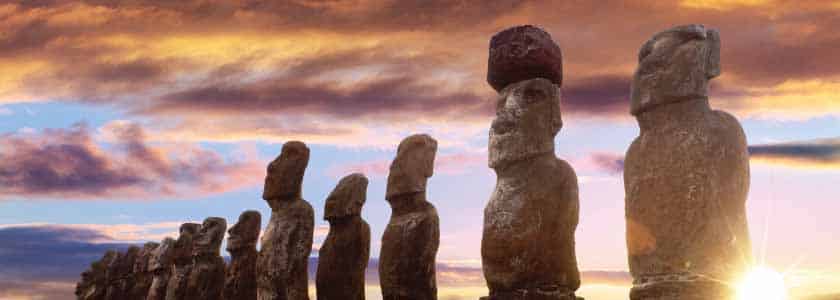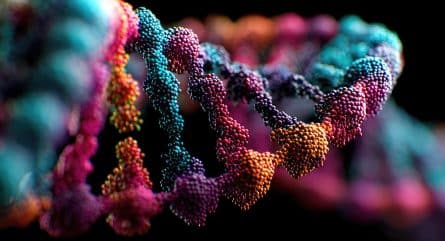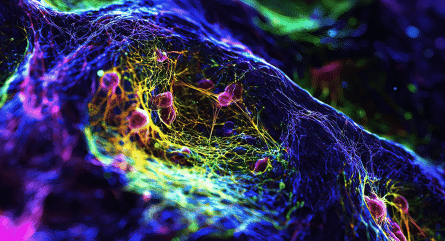About 6,000 years ago, people living on the edge of Asia began to sail east across the Pacific. Crossing hundreds, and sometimes thousands, of miles of open ocean, seafarers settled island chains like Guam in 2000 BC, Fiji and New Caledonia in 1500 BC, and Samoa in 200 BC. Later settlement swept eastward to Tahiti (300 AD), the Cook Islands (800 AD) and Tuvalu (1000 AD). Among the last to be settled was Easter Island, which lies 2,290 miles (3,686 km) west of Chile.
That anyone in a canoe sailing across the ocean could have even found Easter Island at all is itself a miracle. The island, also known as Rapa Nui, is just 63 miles square, and its widest spot measures less than 14.5 miles across. Its highest point is 1,663 feet (507 meters) above sea level—in clear weather, it would be visible from sea for just 50 miles. Save for a lonely rock called Salas y Gomez more than 200 miles away, there’s nothing else but ocean in every direction.
Did Polynesians Reach South America?
While the Polynesian history of Easter Island tells us the island was settled from the west, a tantalizing question has nipped at scientists: Did the Polynesians who settled Easter Island keep going?
There has long been speculation about human ties between the South American mainland and Easter Island. Archaeological research shows that sweet potatoes, a crop of American origin, were on the island as early as 1200 AD (though one study suggests it could have gotten there by long-distance dispersal—i.e., one floated there). There is also evidence of shared words, stonework, which echoes what is found in South America, and a birdman cult, which is also present in South America. In 1947, Norwegian explorer Thor Heyerdal proved that early inhabitants could have sailed from South America to Polynesia when he piloted the Kon-Tiki, a sailing raft made using only the materials and technologies available at the time, from Callao, Peru, to Raroia, French Polynesia, an atoll a few hundred miles west of Tahiti.
Now, a new study published in Nature finds genetic evidence of human ties between South America and Easter Island.
Native American Presence in Polynesia
In this study, researchers analyzed genome-wide variations in Polynesians for signs of Native American admixture and found conclusive evidence for prehistory contact. The results found that people on Easter Island and four other Polynesian islands have small amounts of DNA inherited from people who lived in Colombia about 800 years ago—specifically, they were Zenú, a pre-Columbian culture, which lived on the Caribbean side of northern Colombia, who created rake-like patterns across broad swathes of landscape that likely served as flood control and irrigation waterworks.
DNA from more recent contact—Easter Island has been a Chilean territory since it was annexed in 1888—was ruled out by excluding any DNA that had traces of European ancestry, which is found in most contemporary Chileans.
“The researchers timed this admixture event between Native Americans and Polynesians to about 1200 AD, which is about when the islands were being settled by Polynesians,” noted Genome Web. “The admixture timing estimate varied slightly from island to island, with Rapa Nui exhibiting a later introgression date of 1380, possibly due to the influence of the later Chilean-origin admixture there.”
But adding another kink to the story was the revelation that the earliest sign of DNA contact was not Easter Island but Fatu Hiva, which is much farther away (Fatu Hiva is more than 2,200 miles from Easter Island) but may have been easier to reach.
Writing in a Nature editorial, archaeologist Paul Wallin, who provided peer review for the Nature study, traced human settlement across the Pacific and suggested that migration from Colombia went first to the South Marquesas Islands, and afterward arced south and east toward Palliser, Mangareva, and finally Easter Island.
“The earliest genetic signal of Native Southern Americans found by the authors in Polynesia was from people of the Southern Marquesas Islands, and the authors argue that Colombians mixed with Polynesians there around 1150 AD,” he wrote. “This date is so early that it could even suggest South Americans reached there before Polynesians arrived.”
In other words, it was not the Polynesians who sailed to South America but instead, as postulated by the Kon-Tiki, the South Americans who sailed west.
More studies are needed, noted the authors of the Nature study, as another contact scenario involves Polynesians sailing to South America and returning years later with people carrying South American genetic heritage. More research will also be needed to pin down the introduction of sweet potatoes on to Pacific islands, since a 2013 genetic study indicated the possibility of not one but several introductory events.
The idea that Americans reached Polynesia before the Polynesians got to America is by no means universally accepted. As archaeologist Carl Lipo told National Geographic, “Polynesians are long-distance voyagers. They moved across incredibly vast areas consistently and found all kinds of margins. We often think of these traditional seafaring groups as moving step-like to close islands and then further and further islands over time, but in fact, what we actually see archaeologically is that people move the farthest distance first. They explored their space and actually ended up in some of the most remote islands early on, and then filled in, colonizing the areas in between."
Also casting doubt on that scenario is the fact that no South American tools, pottery, or other items have been found in Polynesia—though, for that matter, no Polynesian tools, pottery or other items have been found in South America, either. And while South American DNA is found in Polynesia, no Polynesian DNA is found in South America.
Doubts were also echoed by Lisa Matisoo-Smith, a biological anthropologist in New Zealand, who told The New York Times that additional DNA studies should compare genetic signatures from Polynesia to those of China to “help rule out the possibility that what looks like Native American ancestry in Polynesia is actually just DNA inherited from the common ancestors of the two groups in Asia.”


























